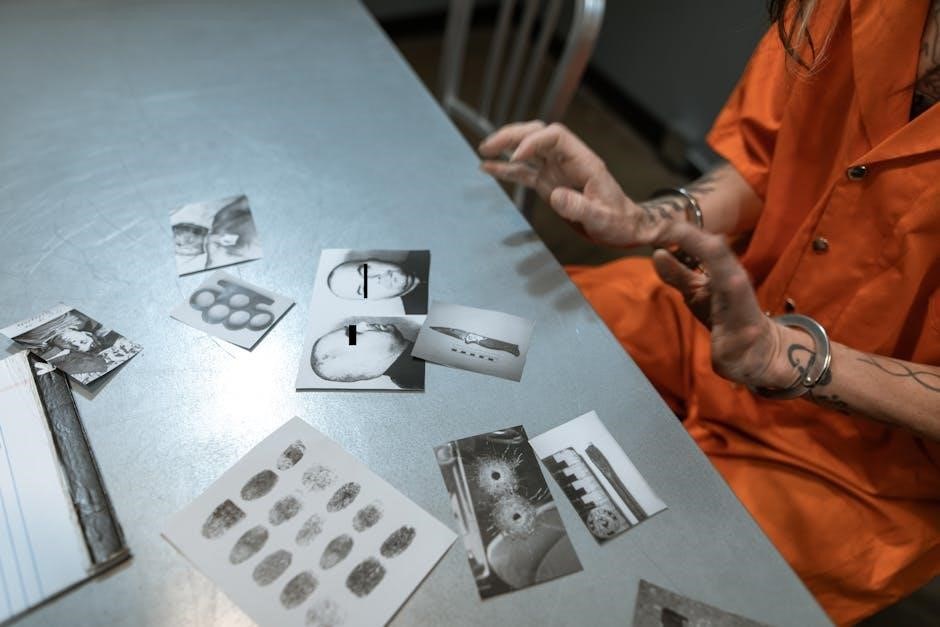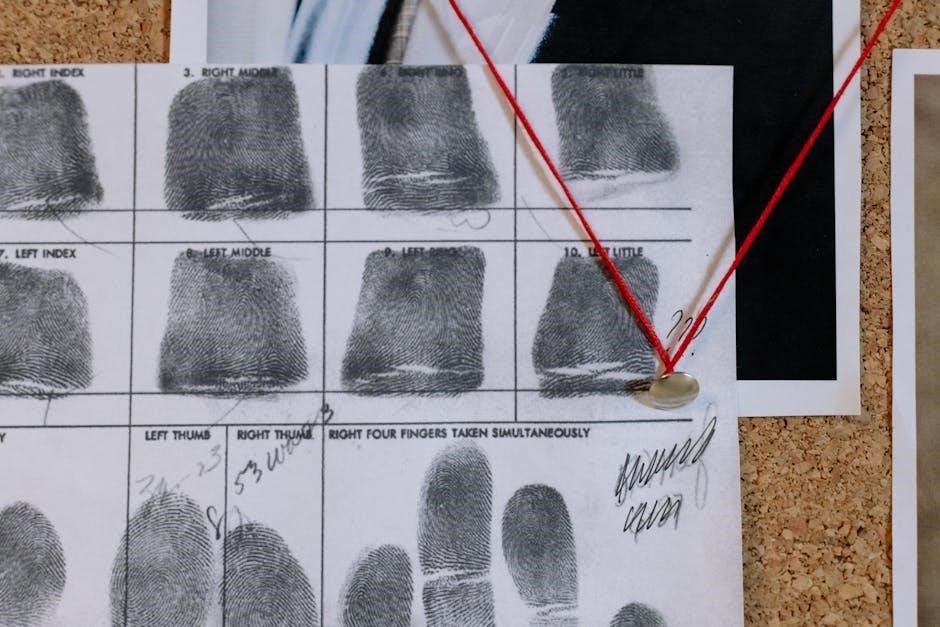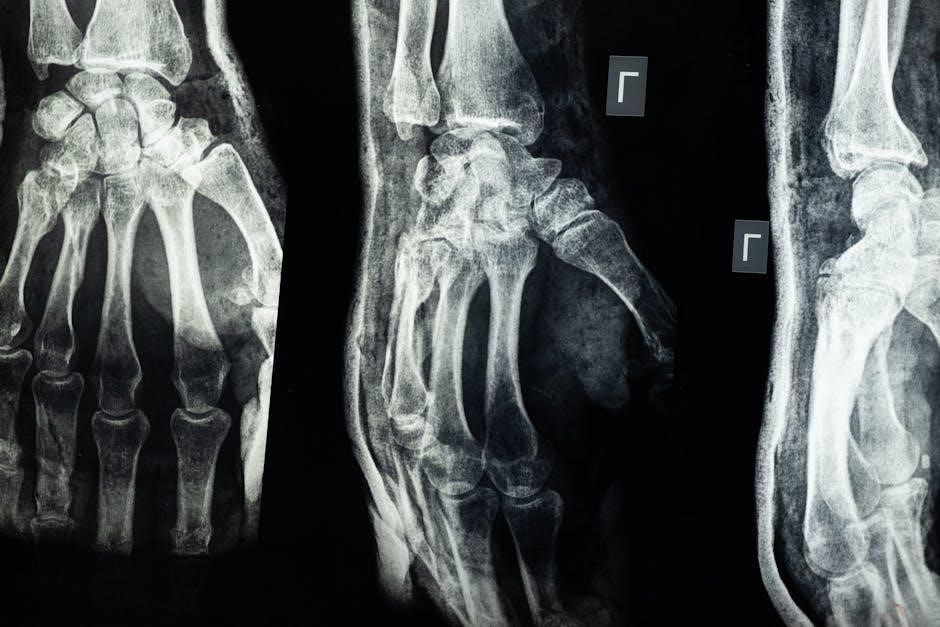Criminal investigation involves systematic processes to gather evidence, solve crimes, and bring offenders to justice. The 11th edition of Criminal Investigation by Hess, Orthmann, and Cho provides a comprehensive guide, offering insights into modern investigative techniques, legal frameworks, and ethical considerations. This resource is essential for students and professionals seeking to understand the complexities of criminal investigations in today’s society.
1.1. Definition and Scope of Criminal Investigation
Criminal investigation is the systematic process of gathering, analyzing, and interpreting evidence to identify and apprehend criminals. It involves a thorough examination of crime scenes, interviews with witnesses, and the use of forensic science to reconstruct events. The scope extends from initial incident response to courtroom presentation, ensuring justice is served. This process is vital in maintaining law and order, as it bridges the gap between law enforcement and the legal system, providing the necessary evidence for fair trials and accountability.
1.2. Importance of Criminal Investigation in Modern Society
Criminal investigation plays a pivotal role in maintaining social order and ensuring justice. By identifying offenders and gathering evidence, it protects the rights of victims and upholds the rule of law. Effective investigations deter crime, foster public trust in law enforcement, and provide closure for affected communities. In modern society, it also addresses complex challenges like cybercrime and organized crime, ensuring safety and stability. The integrity of criminal investigations is essential for a fair and just society, making it a cornerstone of public safety and legal systems worldwide.
1.3. Brief History of Criminal Investigation Techniques
The history of criminal investigation techniques dates back to ancient times, with early methods relying on basic observation and interrogation. The 19th century marked significant progress, introducing fingerprinting and forensic science. The 20th century saw advancements like DNA analysis and psychological profiling. Modern techniques now incorporate digital forensics and AI-driven tools, revolutionizing how crimes are solved; This evolution reflects humanity’s relentless pursuit of justice and accuracy, shaping the sophisticated methods used today to combat increasingly complex criminal activities.

Overview of the 11th Edition of Criminal Investigation
The 11th edition of Criminal Investigation offers comprehensive updates, new chapters, and enhanced digital resources, providing a modern approach to investigative practices and theories.
2.1. Key Features of the 11th Edition
The 11th edition of Criminal Investigation includes updated case studies, expanded coverage of digital forensics, and enhanced visuals. It incorporates the latest investigative techniques, such as DNA analysis and AI tools, providing practical insights for both students and professionals. The edition also features a dedicated chapter on cybercrime, reflecting modern challenges in law enforcement. Additionally, it offers interactive digital resources, including quizzes and multimedia examples, to enhance learning. These features make it a comprehensive resource for understanding contemporary investigative practices and their real-world applications.
2.2. What’s New in the 11th Edition?
The 11th edition introduces new chapters on cybercrime and digital evidence, addressing the growing importance of technology in investigations. It includes updated content on DNA profiling and artificial intelligence, reflecting recent advancements in forensic science. Enhanced case studies provide real-world examples of investigative techniques, while revised chapters on legal frameworks ensure compliance with current laws. The edition also features improved visuals, such as crime scene diagrams, to aid understanding. These updates ensure the text remains relevant and aligns with modern investigative practices and challenges.
2.3. Authors and Their Contributions to the Field
The authors of the 11th edition are renowned experts in criminal investigation, bringing extensive experience in law enforcement, forensic science, and legal processes. Their contributions include updating the text with cutting-edge research and practical insights, ensuring it remains a definitive resource for professionals and students. Their expertise spans forensic psychology, crime scene analysis, and investigative strategies, making them trusted voices in the field. Their work has significantly influenced modern investigative practices and education, providing a comprehensive understanding of criminal investigation techniques and their applications.

Key Concepts and Theories in Criminal Investigation
This section explores foundational theories and concepts, such as evidence analysis, criminal profiling, and investigative strategies, providing a framework for understanding modern investigative practices and their applications.
3.1. The Investigative Process: From Crime Scene to Courtroom
The investigative process begins with securing the crime scene, collecting evidence, and documenting findings. Investigators analyze physical and testimonial evidence to identify suspects. Legal and ethical considerations guide each step to ensure integrity. The process concludes with preparing evidence for courtroom presentation, where findings are scrutinized to establish guilt or innocence. This systematic approach ensures justice is served while upholding procedural fairness and transparency.
3.2. Types of Evidence and Their Significance
Evidence in criminal investigations is categorized into physical, testimonial, and documentary types. Physical evidence includes tangible items like fingerprints, DNA, and weapons, providing factual links between suspects and crimes. Testimonial evidence relies on witness statements and confessions, offering firsthand accounts of events. Documentary evidence comprises records, such as financial transactions or communication logs, which corroborate timelines and motives. Each type plays a crucial role in building a case, ensuring credibility and accuracy in criminal investigations. Proper collection and analysis of evidence are vital for securing justice.
3.3. Criminal Profiling and Behavioral Analysis
Criminal profiling and behavioral analysis are crucial tools in criminal investigations, helping investigators predict a suspect’s characteristics based on crime scene data. By analyzing patterns, motives, and modus operandi, profilers create psychological portraits of offenders, aiding in narrowing down suspects. Behavioral analysis also examines how criminals interact with victims and environments, providing insights into their mindset. These techniques, rooted in psychology and criminology, enhance investigative strategies and improve the likelihood of identifying perpetrators, making them invaluable in solving complex and serial crimes effectively.

Investigative Techniques and Tools
Investigative techniques include forensic science, surveillance, and digital forensics, providing tools to gather evidence, analyze data, and reconstruct crimes for effective case resolution in criminal investigations.
4.1. Forensic Science in Criminal Investigations
Forensic science plays a pivotal role in criminal investigations by analyzing physical evidence to link suspects to crimes. Techniques like DNA analysis, fingerprinting, and toxicology help investigators reconstruct events and identify perpetrators. Advances in technology have enhanced the accuracy and reliability of forensic methods, making them indispensable in modern investigations. Forensic experts often testify in court, providing critical evidence that can make or break a case. The integration of forensic science ensures that investigations are thorough, objective, and grounded in scientific principles, ultimately aiding in the pursuit of justice and truth.
4.2. Surveillance and Undercover Operations
Surveillance and undercover operations are essential tools in criminal investigations, allowing law enforcement to gather evidence and monitor suspicious activities discreetly. Surveillance can involve physical observation, electronic monitoring, or digital tracking, helping investigators build a case without alerting suspects. Undercover operations enable officers to infiltrate criminal networks, gaining insights into illegal activities. Both methods require careful planning and legal oversight to ensure they are conducted ethically and within the bounds of the law. These techniques are critical for preventing crimes and bringing criminals to justice while protecting public safety and security.
4.3. Digital Forensics and Cybercrime Investigation
Digital forensics involves the recovery, analysis, and presentation of data from digital devices to investigate cybercrimes. Techniques include extracting evidence from computers, smartphones, and network systems. Cybercrime investigations focus on offenses like hacking, fraud, and online harassment. Investigators use specialized tools to track digital footprints and uncover hidden data. The field requires constant updates to combat evolving threats. Digital forensics plays a critical role in identifying perpetrators and gathering evidence, ensuring justice in the digital age. It bridges law enforcement and technology to address modern criminal challenges effectively.

Legal Frameworks and Ethical Considerations
This section explores the legal frameworks governing criminal investigations and the ethical considerations ensuring integrity. It covers privacy rights, justice balance, and ethical practices preventing misconduct.
5.1. Legal Rights of Suspects and Victims
This section discusses the legal rights of suspects and victims in criminal investigations. It emphasizes the protection of suspects’ rights, such as Miranda rights and the right to counsel, while ensuring victims’ rights to protection, compensation, and participation in proceedings. The chapter highlights the importance of upholding these rights to maintain justice and fairness, preventing wrongful convictions and ensuring ethical investigative practices. Proper adherence to legal frameworks is crucial for balancing the rights of all parties involved in criminal investigations.
5.2. Ethical Dilemmas in Criminal Investigations
Ethical dilemmas in criminal investigations often arise when balancing justice with individual rights. Issues like police brutality, evidence tampering, and racial profiling can undermine public trust. Investigators may face moral choices, such as using deceptive tactics or prioritizing case closure over ethical practices. These challenges highlight the need for strict ethical guidelines and accountability to ensure fairness and integrity in the investigative process. Addressing these dilemmas is crucial for maintaining public confidence and upholding the principles of justice.
5.3. Admissibility of Evidence in Court
The admissibility of evidence in court is a critical factor in criminal investigations. Evidence must be relevant, reliable, and obtained legally to be considered admissible. Common issues include chain of custody, contamination, and violations of legal procedures. If evidence is deemed inadmissible, it can significantly weaken a case or lead to its dismissal. Investigators must ensure all evidence is collected and handled properly to meet legal standards. Proper documentation and adherence to procedural guidelines are essential to maintaining the integrity of evidence for courtroom presentation.

The Role of Technology in Modern Investigations
Technology has revolutionized criminal investigations by enhancing forensic tools, improving digital evidence analysis, and enabling real-time data sharing. It ensures efficiency and accuracy, aiding investigators in solving crimes faster while maintaining ethical standards in evidence collection and analysis processes.
6.1. DNA Analysis and Its Impact on Investigations
DNA analysis has become a cornerstone in criminal investigations, providing precise identification and linking suspects to crime scenes. By analyzing biological evidence like blood or saliva, investigators can solve cases with unparalleled accuracy. DNA profiling, combined with databases like CODIS, has revolutionized cold case resolutions and exonerated wrongly convicted individuals. Its reliability has made it a critical tool, ensuring justice and accountability while minimizing human error. Ethical considerations, such as privacy concerns, are balanced with its transformative impact on forensic science and public safety.
6.2. Facial Recognition and Biometric Identification
Facial recognition and biometric identification have transformed criminal investigations by enabling rapid identification of suspects. These technologies analyze unique physical features, such as facial structures or fingerprints, to match individuals with databases. They are particularly effective in identifying suspects from surveillance footage or crime scene evidence. While they enhance public safety, concerns about privacy and algorithmic bias persist. Proper regulation and ethical use are essential to balance their investigative benefits with individual rights. These tools represent a significant leap in modern investigative capabilities, aiding in crime prevention and resolution.
6.3. Artificial Intelligence in Crime Solving
Artificial intelligence (AI) has revolutionized crime solving by enhancing predictive policing, pattern analysis, and data processing. Machine learning algorithms analyze vast datasets to identify criminal behaviors and predict potential offenses. AI tools also aid in forensic analysis, helping investigators process evidence faster and more accurately. However, challenges like data privacy and algorithmic bias must be addressed. AI’s integration into criminal investigations offers immense potential to improve efficiency and accuracy, making it a critical tool for modern law enforcement. Its role continues to expand, reshaping investigative practices globally.

The Criminal Justice System and Its Components
The criminal justice system encompasses law enforcement, courts, and corrections, working collectively to maintain justice, enforce laws, and rehabilitate offenders, ensuring societal safety and order.
7.1. Law Enforcement Agencies and Their Roles
Law enforcement agencies, such as local police departments and federal organizations, play a critical role in criminal investigations. Their primary responsibilities include crime prevention, conducting preliminary investigations, collecting evidence, and apprehending suspects. These agencies collaborate with prosecutors and courts to ensure cases are thoroughly investigated and legally sound. Their work is essential in upholding justice, protecting communities, and maintaining public order. Effective law enforcement is the foundation of the criminal justice system, ensuring that investigations are conducted ethically and legally.
7.2. The Court System and Trial Process
The court system serves as the cornerstone of criminal justice, where evidence collected during investigations is presented to determine guilt or innocence. The trial process involves pre-trial motions, jury selection, and the presentation of testimony from witnesses. Prosecutors and defense attorneys argue their cases, with judges ensuring legal procedures are followed. The jury delivers a verdict, and if guilty, sentencing occurs. This process ensures accountability and justice, relying heavily on the integrity of evidence and legal arguments. The court system’s role is pivotal in resolving criminal cases fairly and transparently.
7.3. Corrections and Rehabilitation in Criminal Justice
Corrections and rehabilitation are critical components of the criminal justice system, focusing on punishing offenders and preparing them for reintegration into society. Incarceration facilities, such as prisons and jails, aim to secure public safety while providing opportunities for rehabilitation. Programs like education, counseling, and vocational training are designed to reduce recidivism and foster personal growth. Rehabilitation emphasizes addressing underlying issues, such as substance abuse or mental health, to help offenders lead law-abiding lives. Effective correctional systems balance punishment with rehabilitation, ensuring safer communities and supporting offenders’ successful reentry.

Case Studies and Real-World Applications
Case studies provide real-life examples of criminal investigations, offering insights into techniques, challenges, and outcomes. Famous cases, such as the Jack the Ripper murders or the Golden State Killer, highlight investigative strategies and technological advancements. These examples educate students and professionals on effective methods and ethical considerations in solving crimes.
8.1. Famous Criminal Cases Solved Through Investigation
Famous criminal cases, such as the Lindbergh Baby Kidnapping and the Golden State Killer, demonstrate the power of investigative techniques. The Lindbergh case highlighted forensic evidence and Dr. Bruck’s pioneering work. The Golden State Killer case showcased DNA profiling and genealogy databases. These cases are often studied in the 11th edition, providing insights into modern investigative strategies. They illustrate how advancements in technology and meticulous detective work can solve even the most complex crimes. Such examples are invaluable for educating students and professionals in criminal investigation.
8.2. Lessons Learned from High-Profile Investigations
High-profile investigations, like the O.J. Simpson case and the 9/11 attacks, provide valuable lessons. The O.J. Simpson case emphasized the importance of DNA evidence and media influence. The 9/11 attacks highlighted the need for improved intelligence sharing. These cases, covered in the 11th edition, reveal how investigative strategies can be refined. They also underscore the importance of forensic accuracy and public trust in law enforcement. Such lessons are crucial for improving investigative practices and ensuring justice is served effectively.
8.3. The Impact of Investigative Mistakes on Cases
Investigative mistakes can have profound consequences, leading to wrongful convictions, case dismissals, or loss of public trust. For instance, mishandling evidence or coercive interrogation techniques can taint outcomes. The Innocence Project highlights cases where DNA exonerations revealed prior investigative errors. Such mistakes underscore the need for rigorous training, oversight, and adherence to ethical standards. Addressing these issues is crucial for maintaining the integrity of criminal investigations and ensuring justice is served fairly and accurately, as discussed in the 11th edition of Criminal Investigation.

The Future of Criminal Investigation
The future of criminal investigation lies in advancing technologies, global collaboration, and refined methodologies to combat evolving crimes effectively and ethically.
9.1. Emerging Trends in Investigative Practices
Emerging trends in criminal investigation include the integration of AI for predictive policing, advanced digital forensics, and biometric technologies. These tools enhance evidence analysis and suspect identification. The use of 3D crime scene reconstruction and virtual reality is also on the rise, aiding investigators in visualizing and solving complex cases. Additionally, there is a growing emphasis on ethical practices to ensure privacy and transparency in investigations. These advancements are reshaping how crimes are approached, making investigations more efficient and precise.
9.2. The Role of Global Cooperation in Fighting Crime
Global cooperation is crucial in combating transnational crimes like cybercrime, terrorism, and human trafficking. International collaboration enables the sharing of intelligence, best practices, and resources. Law enforcement agencies worldwide harmonize efforts through organizations like Interpol, fostering cross-border investigations. Joint operations and extradition treaties enhance the ability to apprehend criminals who operate globally. This unity strengthens legal frameworks and ensures criminals cannot evade justice by exploiting jurisdictional gaps. Effective global cooperation is essential for addressing complex, modern criminal enterprises.
9.3. The Challenges of Investigating Transnational Crimes
Investigating transnational crimes presents unique challenges, including jurisdictional complexities, differing legal systems, and language barriers. Coordinating efforts across borders requires international agreements and cooperation, which can be time-consuming. Technological advancements, such as encryption, often hinder access to critical evidence. Additionally, the involvement of organized crime groups and corrupt officials complicates investigations. Resource disparities between countries further exacerbate these challenges. Despite these obstacles, collaborative efforts and advanced investigative tools are essential to combat transnational criminal enterprises effectively.

Accessing the 11th Edition for Free
Accessing the 11th edition for free is convenient via online platforms, but ensure legality and ethicality. Check libraries or educational institutions for legitimate access options.
10.1. Legal and Ethical Considerations of Downloading Free PDFs
Downloading free PDFs of the 11th edition may violate copyright laws, as it involves unauthorized distribution of intellectual property. Publishers and authors invest significant time and resources into creating such materials, and piracy undermines their efforts. Legal consequences, including financial penalties, can arise from downloading or sharing pirated content. Ethically, it is important to respect intellectual property rights and support authors by purchasing legitimate copies. Always verify the legality of sources before accessing academic materials.
10.2. Reliable Sources for Downloading Academic Materials
Accessing academic materials like the 11th edition of Criminal Investigation requires using reputable sources. University libraries often provide digital access to textbooks through platforms like JSTOR or ProQuest. Official publisher websites, such as Pearson or Cengage, offer legitimate purchase or rental options for e-books. Additionally, academic platforms like Google Scholar or ResearchGate may host shared resources, though verification of authenticity is essential. Always prioritize official channels to ensure compliance with copyright laws and support authors and publishers.
10.3. The Importance of Supporting Authors and Publishers
Purchasing academic materials like the 11th edition of Criminal Investigation ensures authors and publishers receive fair compensation for their work. This support enables the creation of high-quality educational resources. By buying legitimate copies, you contribute to the sustainability of academic publishing and uphold copyright laws. Avoiding pirated materials respects intellectual property and promotes ethical scholarship. Investing in official sources also guarantees access to accurate and updated content, which is crucial for educational and professional development.



